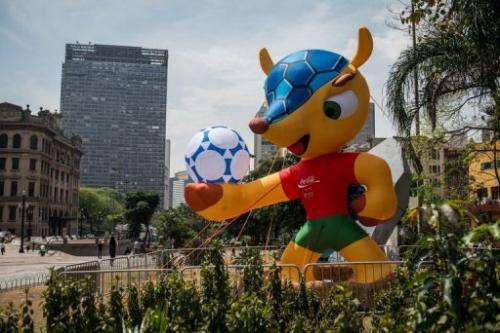An inflatable mascot of the FIFA World Cup Brazil 2014, a "Tatu-bola" is displayed in Sao Paulo, Brazil, on September 24, 2012. The three-banded armadillo, a threatened species chosen as the official mascot for the 2014 World Cup, could disappear entirely within decades, a Brazilian NGO has warned.
The three-banded armadillo, a threatened species chosen as the official mascot for the 2014 World Cup, could disappear entirely within decades, a Brazilian NGO has warned.
Indigenous to Brazil, where it is known as the "tatu-bola," the animal "is at risk and, if nothing is done immediately in terms of conservation, the species could be extinct within 50 years," Rodrigo Castro, executive head of the Caatinga NGO, was quoted as saying Saturday.
"It is a species which feels changes in the environment. If there is deforestation, forest fires, urban sprawl or expansion of farmlands, it disappears because it does not bear climate change," Castro told the official Agencia Brasil.
Caatinga led the drive to make the poorly known tatu-bola the mascot for the first World Cup to be staged in Brazil since 1950.
The animal is listed as vulnerable on the Red List of Threatened Species maintained by the International Union for Conservation of Nature (IUCN).
Agencia Brasil said the government plans to announce a change in the tatu-bola's status early next year, from "vulnerable" to "at risk of extinction."
The animal, which is said to have lost more than 50 percent of its habitat over the past 10 years, had been believed extinct until it was rediscovered in 1988.
When threatened, the tatu-bola rolls up into an almost impenetrable ball with its ears tucked into the shell and the head and tail interlocked to seal the shell completely.
(c) 2012 AFP






















